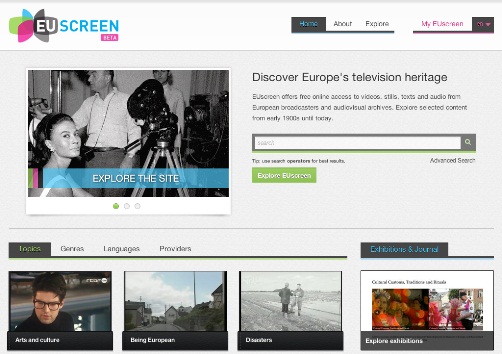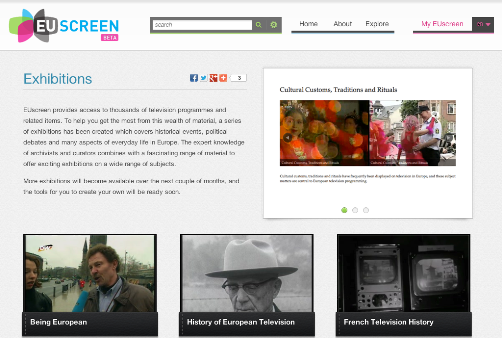As the EUscreen project draws to a close, in a special extended blog post Erwin Verbruggen tells us about its achievements and how work will continue once the project is over. All at Europeana would like to give a huge congratulations to everyone involved in EUscreen on their recent Lovie Award for Television – don’t forget to vote for them in the People’s Lovie Award category too!
EUscreen started in 2009 in an effort to enable users from varying backgrounds to explore Europe's television heritage through an attractive portal. This focus on user studies and design has been well rewarded: the EUscreen website received a Silver award for 'Television' in the second annual
Lovie Awards, the only pan-European award to honour the entire breadth of content created for the internet, and the prestigious
Webby Awards' European sister. This is an unparalleled honour. The site was chosen by the expert members of the
International Academy of Digital Arts and Sciences (IADAS) from nearly 1,000 entries from over 20 countries in Europe.
Over the past three years, EUscreen has worked on an effort never seen before: 40,000 items - fragments, full programmes, documents and photographs from a wide array of European broadcasters - have been made available freely online, with extensive metadata in two languages, on a multilingual, sleekly designed platform. The main motivation for the initiative is to provide unified access to a representative collection of television programmes, secondary sources and articles, and in this way to allow students, scholars and the general public to study the history of television in its wider context.
Connectedness: Linked Open Data
Galleries, libraries, archives and museums across the world are beginning to explore the added value of sharing data resources following something called Linked Open Data (LOD) principles. Linked Data aim to make data accessible not only to humans but also to machines and software agents. It builds a layer that enables automatic links between different signifiers (for example a director, or an event such as a specific football match) to improve and enrich their interaction.
In 2012, EUscreen launched its
Linked Open Data Pilot, based on the Resource Description Framework (RDF) representation of the data, and structured it using the
EBU Core ontology. The aim of the pilot is to demonstrate the added value of adhering to LOD standards in the cultural heritage domain. The data, made available under a
CC0 declaration, served by
lod.euscreen.eu/resource is generated from the metadata EUscreen has harvested using the
MINT ingestion platform.
In addition to the original data harvested by EUscreen from its data providers, the data served at
lod.euscreen.eu/resource includes:
- internal links to other videos that are also served by lod.euscreen.eu/resource/
- semantic enrichment done by NTUA, connecting EUscreen videos to structured representations of places and languages.
In particular, EUscreen content has been enriched by its linking to external data sources like the
DBpedia,
Eurostat,
Freebase and
NY Times allowing for more expressive search and retrieval.
Entry Points: Virtual Exhibitions
The design and implementation of a range of
EUscreen Virtual Exhibitions has been ongoing since summer 2011, led by
Noterik and
Aalto University School of Arts, Design and Architecture. The tools designed for these exhibitions allow for the insertion of multimedia materials from all the project's content providers and links back to the original items on the site, where users can find out more about them, share the links or get in touch with the providers themselves.
Workshops have played an important part in designing the exhibition tools. Programmers and interface designers have worked hands-on in close collaboration with the scholars who curated the first exhibitions. This collaboration and further testing and feedback from EUscreen content providers has enabled a range of needs and perspectives regarding audiovisual storytelling to be taken into account.
As a result, we developed an Exhibition Builder tool, which provides a WYSIWYG style interface for creating online exhibitions. With this tool, it is possible to select different layouts, add media from EUscreen, and enrich it further with, for example, texts and links to external websites as well as direct links to parts of videos.
Examples of EUscreen's virtual exhibitions include: a journey through French broadcasting history; an exploration of Dutch architecture; and the role of women in sport in Sweden. As well as these individually curated exhibitions, a range of exhibitions draw upon material provided by all EUscreen project contributors to showcase topics like fashion, food, culture and religion.
Creative Re-use: Open Video
The second EUscreen conference focused on Re-use and Creativity. A significant milestone related to this topic is the production of an Open EUscreen portal, which advances the work on re-use executed in the project. Thanks to the enthusiastic responses from some partners, we've been able to develop and advance a separate EUscreen platform on Open Images. This is an open media platform that offers online access to audiovisual archive material to stimulate creative re-use. Footage from audiovisual collections can be downloaded and remixed into new works. Open Images also provides an API, making it easy to develop mashups. The 'open' nature of the platform is underscored by the use of open video formats (Ogg Theora), open standards (HTML5, OAI-PMH) and open source software components. Furthermore, all software that is developed within the scope of Open Images will also be released under the GNU General Public Licence.
The site will be up at http://euscreen.openimages.eu to coincide with this week's Open Access Week!
Research and Display: Open Access Journal
The EUscreen project and the European Television History Network are the birthplace of VIEW, the open access Journal of European Television History and Culture. It is the first peer-reviewed, multimedia and open access e-journal in the field of European television history and culture. It offers an international platform for outstanding academic research and archival reflection on television as an important part of our European cultural heritage. With its interdisciplinary profile, the journal is open to many cross-disciplinary perspectives on European television including television history, media studies, media sociology, cultural studies and television studies.
The first issue of the Journal of European Television History and Culture, published in March 2012, followed up on the central theme of the first EUscreen conference held in Rome in October 2010 and explicitly addressed the challenges of contextualising television material online. The second issue will come out at the end of this month and discuss 'Europe on and behind the screens'. What's more, you can view the multimedia elements discussed within the online articles.
Future Work
In relation to the virtual exhibitions, future work will be focused on:
- Exception-based IPR: allowing content owners to set the rights of re-use in flexible ways per collection, per video or even per parts of videos.
- Content-based editing: this is a process by which videos are edited based not on time but by adding time-based entity information and concepts. This means it would be possible to shift editing from the moment of production to the moment of viewing/consuming, allowing for multiple montages that all still reflect the wishes/intent of the creators.
We anticipate these alternative item discovery methodologies will attract new user-groups to engage with the rich body of content offered by the archives represented in the EUscreen consortium.
Vote for EUscreen!
Expect the latest series of exhibitions to be released on Saturday when, one year after launching the EUscreen portal, archives worldwide
celebrate their audiovisual heritage as part of the UNESCO World Day for Audiovisual Heritage.
Glossary
CC0 – Creative Commons CC0 1.0 Universal Public Domain Dedication. By licensing data under ‘CC0’, all copyright and other rights are waived. This means anyone can use the information under CC0 however they choose, for commercial or non-commercial purposes.
EBUcore - The EBUCore is a metadata specification designed for users with different needs. It has been purposefully designed as a minimum and flexible list of attributes to describe audio and video resources for a wide range of broadcasting applications.
IPR - Intellectual Property Rights
MINT - MINT services compose a web-based platform that was designed and developed to facilitate aggregation initiatives for cultural heritage content and metadata in Europe.
RDF - Resource Description Framework - a metadata data model for expressing web resources.
WYSIWYG - What you see is what you get - The term is used in computing to describe a system in which content displayed onscreen during editing appears in a form closely corresponding to its appearance when printed or displayed as a finished product.


